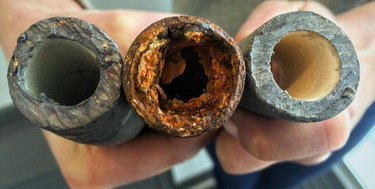Altamont’s asbestos-cement water pipes safe, says DPW super
ALTAMONT — The pipe that burst on Schoharie Plank Road West in late September was made of a well-known cancer-causing material but due to decades of microorganism buildup, water testing is not needed, according to Superintendent of Public Works Jeff Moller.
Moller said no testing is needed because of the “biofilm” that has built up on the inside of the asbestos-cement water pipe, which has acted as a barrier between the asbestos pipe and village water supply. Moller said that all water lines protect themselves in the same way.
The older mains are more susceptible to biofilm buildup, he said, “which is good. But in another sense, it cannot be good.” If too much of the biofilm gets built-up, bacteria starts to grow on the buildup and “your chlorine can’t reach it.”
That’s one of the reasons why villagers will see hydrants being flushed. Moller’s department is actually flushing out the water mains, which is done twice a year, so the biofilm doesn’t get too built-up.
Moller and his DPW crew have to be careful if they cut into the pipe — but the department doesn’t use “any cutting machines like we normally would on a water main to create dust,” he said, so, other than protecting the workers, the village doesn’t have to do anything extra in terms of safeguarding, because of the biofilm.
“The primary reason for concern about drinking water containing asbestos fibers is the association between occupational asbestos exposure and gastrointestinal cancer shown in a number of occupational epidemiology studies,” according to the Environmental Protection Agency. “Although the asbestos worker is exposed to airborne asbestos it has been clearly demonstrated that a high percentage of inhaled fibers deposited in the lung are cleared and swallowed. So, they are also exposed to ingested fibers. There have been a number of recent studies which have shown that asbestos fibers can penetrate the digestive tract and even are excreted through the urine.”
Asked how much asbestos-cement water pipe Altamont has, Moller said, “There isn’t that much really at all.”
But his response came with a caveat: “This is what we know of,” meaning knowledge was attained through years of digging up water-main breaks.
Moller said there is asbestos-cement pipe on Maple Avenue Extension and Schoharie Plank Road West. “And right now, those are the only places that we really know that we have it in our system,” he said. And not all of Schoharie Plank Road West is asbestos-cement pipe, Moller said; a lot of the main is cast iron.
He surmised the asbestos pipe was used as a “fill in” in the 1940s.
Moller said that, when he arrived in Altamont 20 years ago, the village didn’t really have any sort of water-system map. His department has spent the past two decades creating its own maps as it fixes the village’s main breaks.
Four types of pipe make up the village’s water-distribution system: plastic, cast iron, ductile iron, and asbestos-cement. That doesn’t include the abandoned but still-in-the-ground wooden pipes that first made up the system, which dates back to 1893.
The village began swapping out the 128-year-old wooden system with cast iron in 1909, when 7,000 feet of transmission main coming from the Altamont reservoir was replaced. In 1930, all remaining wooden water mains were replaced with cast iron.
On Schoharie Plank Road West, 60 feet of asbestos-cement water main was replaced with plastic pipe.
The only way the village would be able to determine if the asbestos pipe were being used in other parts of the water system, would be to come across it while fixing a new break.
Asked about testing for asbestos, Moller said, “It’s all done through our testing,” but it may not be annually — it depends on a testing schedule, which could take place every year, every two years, or even every three years. “It all depends,” he said.
The annual drinking-water quality reports available on the village website, from 2018 and 2019, have no mention of asbestos testing.
County testing archived on the Environmental Protection Agency website dating back to 2003 found no deficiencies with the village water. But the EPA also notes Altamont was cited for violations three times by the state in that same period, typically for having higher-than-allowable levels of disinfects in the water.



